Question
Issue: How to fix Event ID 8193: Volume Shadow Copy Service error in Windows?
Hello. I keep seeing the Event ID 8193: Volume Shadow Copy Service error in Event Viewer on Windows. How do I fix this?
Solved Answer
Event ID 8193 is a common error that occurs in Windows' Volume Shadow Copy Service (VSS).[1] The VSS is a Windows feature that allows the creation of snapshots or shadow copies of files and folders on the system while they are in use. These shadow copies can be used to recover data in the event of accidental deletion or other types of data loss.
The Volume Shadow Copy Service allows backups and restore points to be created without shutting down the system or requiring users to close applications that may be using the files being backed up. This feature is especially beneficial to businesses and organizations that must ensure the availability and integrity of data on their systems.
When the VSS is unable to complete a backup or restore operation due to permissions or other system settings issues, the Event ID 8193 error occurs. This can have a variety of consequences, including data loss or the inability to restore data from a backup. It may also impair system performance or stability.
Checking system permissions, ensuring that the VSS service is running, and making changes to system settings that may be interfering with the VSS are all possible solutions to the Event ID 8193 error. It is important to note that changing the system registry or other system settings can be risky.
In this guide, you will find 5 steps that should help you fix Event ID 8193: Volume Shadow Copy Service error in Windows. Keep in mind that the manual troubleshooting process can be lengthy. You can use a maintenance tool like FortectMac Washing Machine X9 that can fix most system errors, BSODs,[2] corrupted files, and registry[3] issues. Otherwise, follow the step-by-step instructions below.
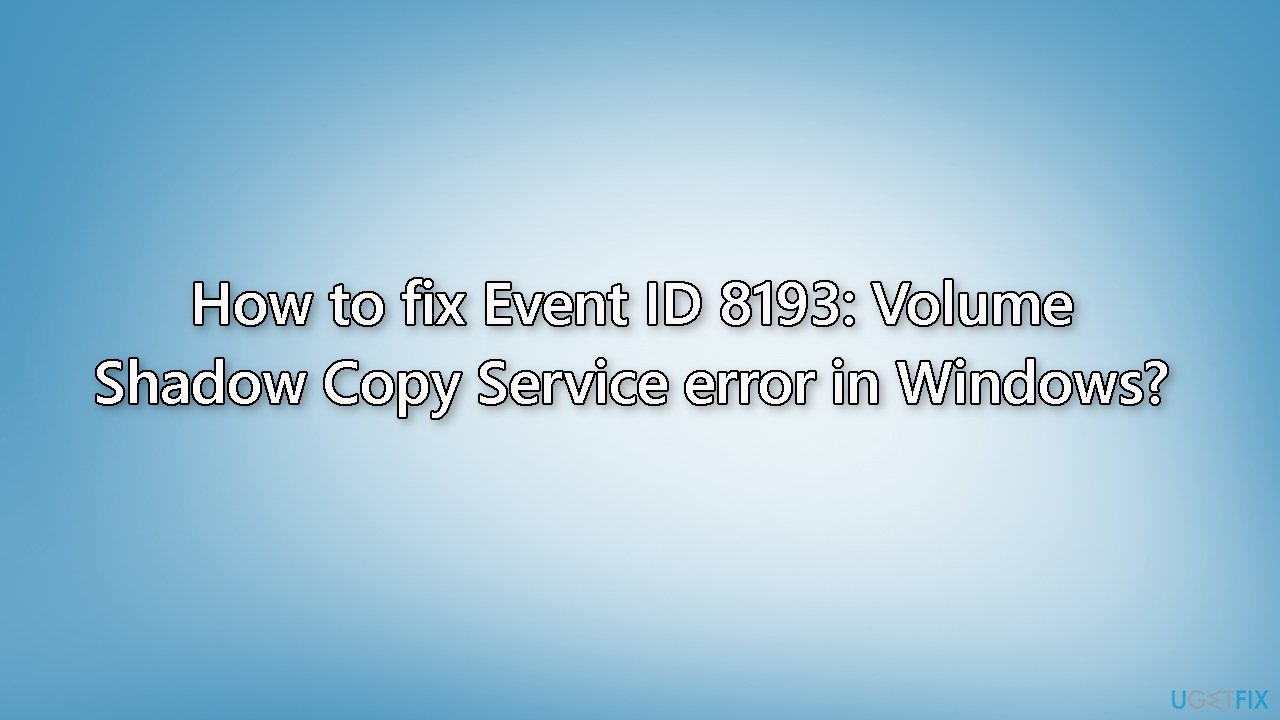
Method 1. Fix Corrupted System Files
Use Command Prompt commands to repair system file corruption:
- Open Command Prompt as administrator
- Use the following command and press Enter:
sfc /scannow
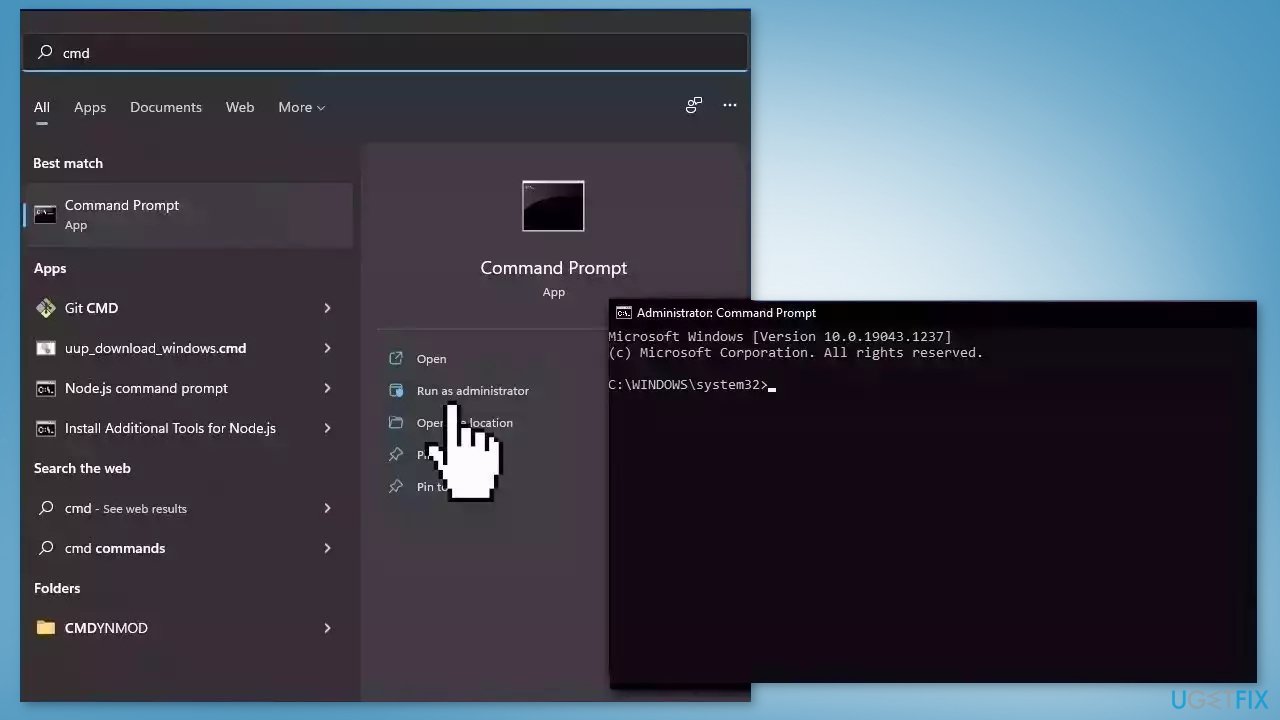
- Reboot your system
- If SFC returned an error, then use the following command lines, pressing Enter after each:
DISM /Online /Cleanup-Image /CheckHealth
DISM /Online /Cleanup-Image /ScanHealth
DISM /Online /Cleanup-Image /RestoreHealth
Method 2. Allow Permissions for Diag
Registry Editor:
- Open the Registry Editor and navigate to the following path:
Computer\HKEY_LOCAL_MACHINE\SYSTEM\CurrentControlSet\Services\VSS\Diag
- Right-click on the Diag key and select Permissions
- Under Permissions Allow Full Control and click on OK to save the changes
- Close the Registry Editor and check if the issue is gone
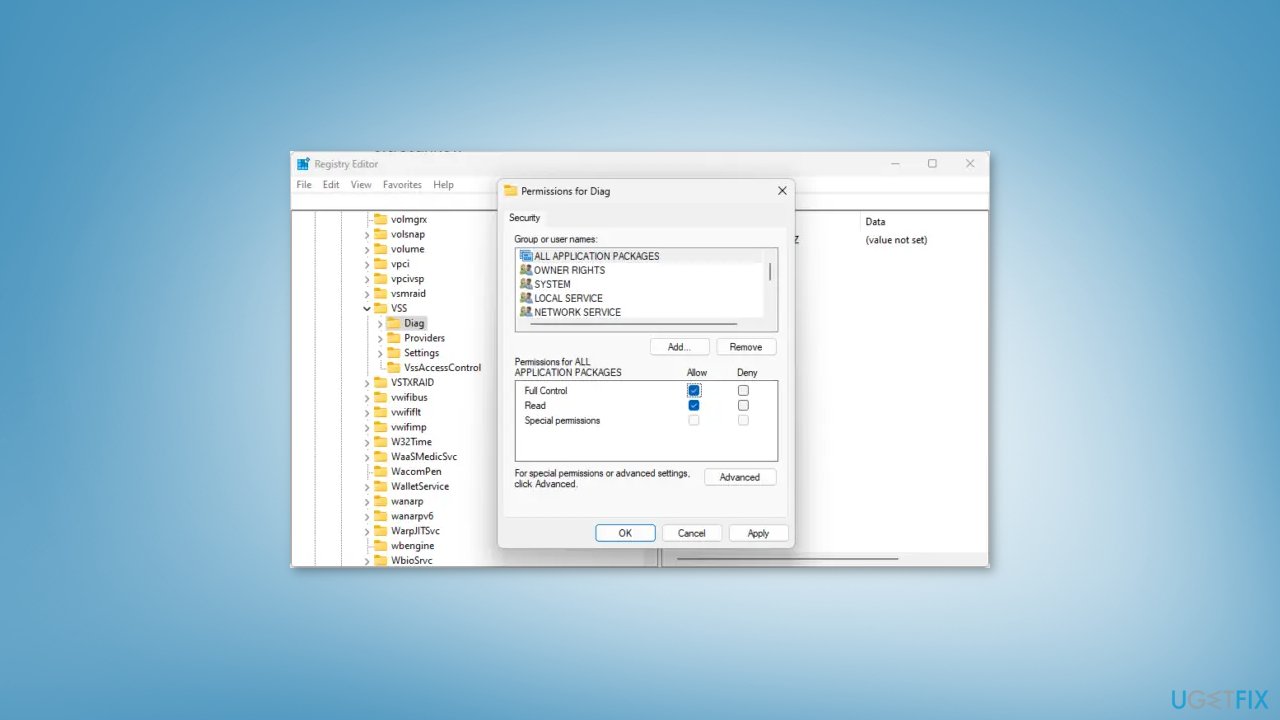
PowerShell:
- Open Windows Powershell as an Administrator
- Type the following commands and hit Enter after each one:
$path = 'HKLM:\System\CurrentControlSet\Services\VSS\Diag\'
$sddl = 'D:PAI(A;;KA;;;BA)(A;;KA;;;SY)(A;;CCDCLCSWRPSDRC;;;BO)(A;;CCDCLCSWRPSDRC;;;LS)(A;;CCDCLCSWRPSDRC;;;NS)(A;CIIO;RC;;;OW)(A;;KR;;;BU)(A;CIIO;GR;;;BU)(A;CIIO;GA;;;BA)(A;CIIO;GA;;;BO)(A;CIIO;GA;;;LS)(A;CIIO;GA;;;NS)(A;CIIO;GA;;;SY)(A;CI;CCDCLCSW;;;S-1-5-80-3273805168-4048181553-3172130058-210131473-390205191)(A;ID;KR;;;AC)(A;CIIOID;GR;;;AC)S:ARAI'
$acl = Get-Acl -Path $Path
$acl.SetSecurityDescriptorSddlForm($sddl)
Set-Acl -Path $Path -AclObject $acl
- Close the PowerShell window
Method 3. Remove Temporary Internet Files
- Open File Explorer
- Type C:\Windows\Microsoft.NET\Framework64\v2.0.50727\TemporaryInternetFiles in the text box at the top and hit Enter
- This will open the Temporary Internet Files folder
- Select all files and folders within the folder by pressing Ctrl + A
- Press Delete to delete all files
- If prompted to confirm the action, click on Yes
- Restart your computer
- Check if the error has been fixed
Method 4. Use System Restore
System Restore is a feature in Microsoft Windows that allows users to revert their computer's state to a previous point in time. This can be helpful if you have made changes to your system that are causing problems.
- Go to the Start menu, type restore, and click on Create a restore point
- Click System Restore, then follow the prompts until you can select a restore point
- Select the one you want (ideally before the issue started occurring) and go ahead with the process
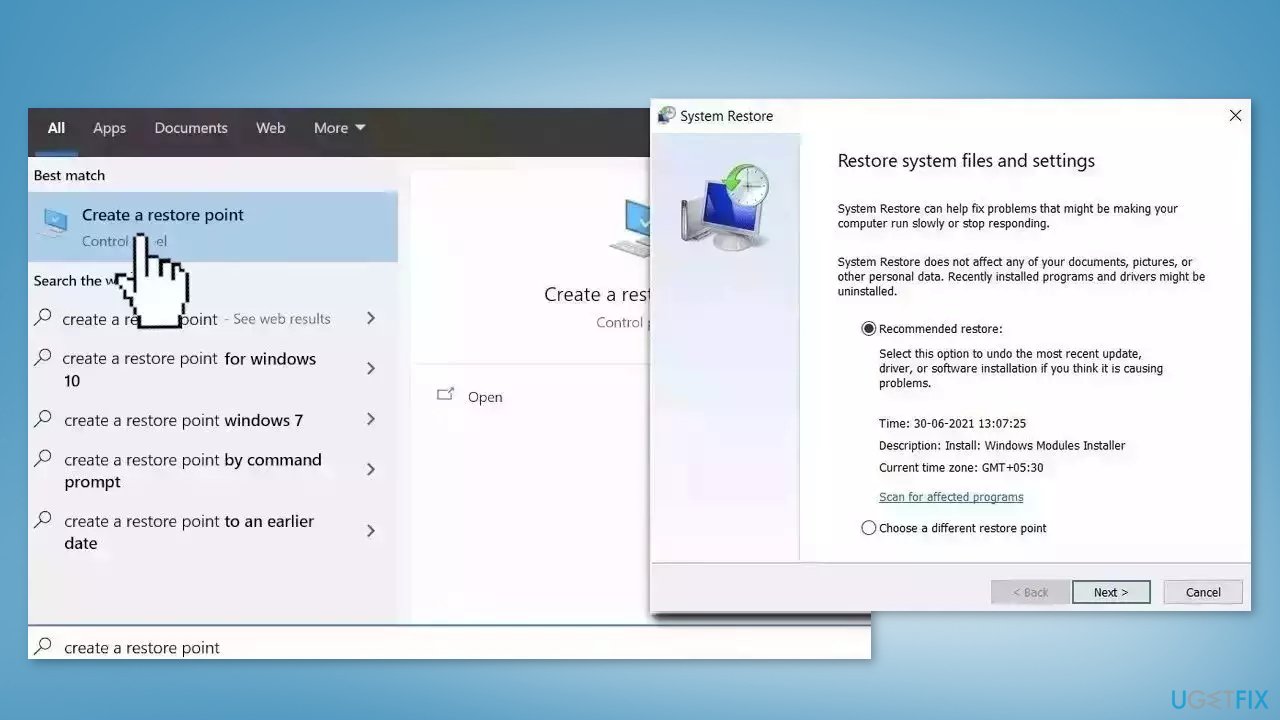
Method 5. Repair Install Windows
- Visit the official Microsoft website to download Windows 11 or Windows 10 Installation Media
- Run the Media Creation Tool and select Create Installation Media for another PC
- Select your USB drive
- Let the Process complete of writing the Installation files to the USB drive
- Click Finish
- On the PC you wish to upgrade, Press Windows + E to open the File Explorer
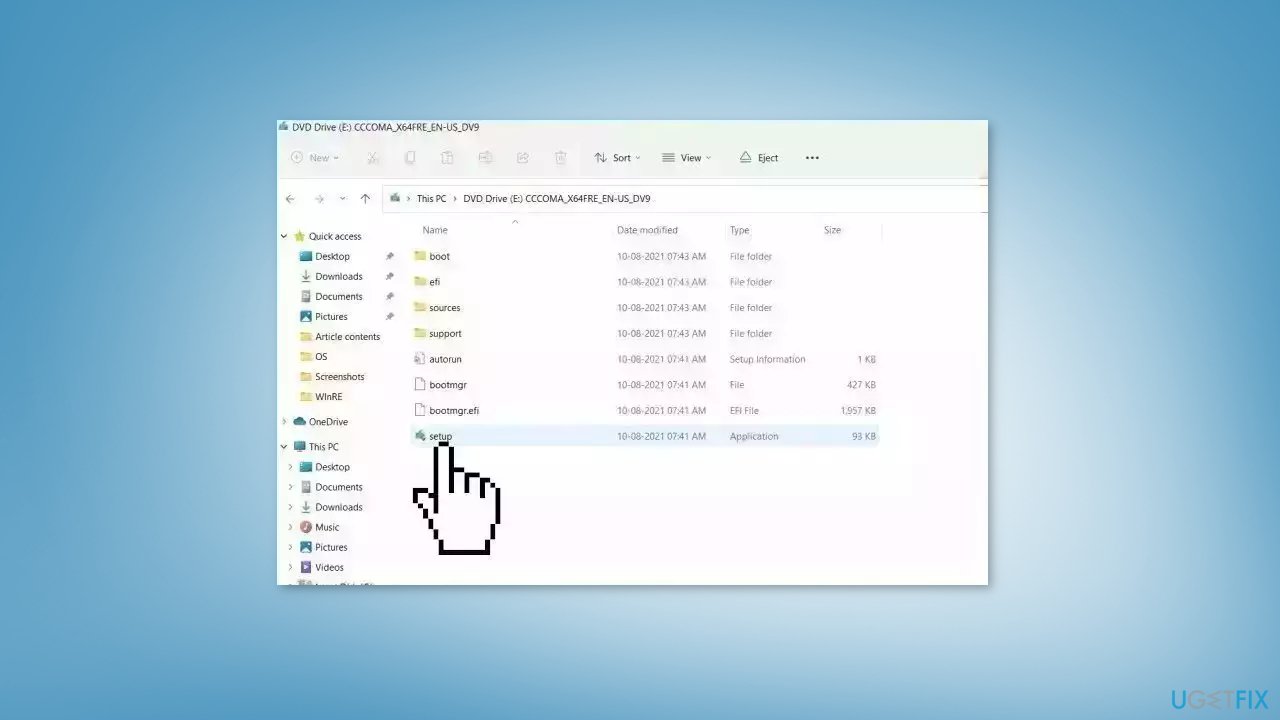
- Open the Removable drive and click Setup.exe
- Accept the license terms on the next screen
- Confirm the Upgrade options – Files, apps and Settings are kept
- Click Install, and the upgrade should start
Repair your Errors automatically
ugetfix.com team is trying to do its best to help users find the best solutions for eliminating their errors. If you don't want to struggle with manual repair techniques, please use the automatic software. All recommended products have been tested and approved by our professionals. Tools that you can use to fix your error are listed bellow:
Prevent websites, ISP, and other parties from tracking you
To stay completely anonymous and prevent the ISP and the government from spying on you, you should employ Private Internet Access VPN. It will allow you to connect to the internet while being completely anonymous by encrypting all information, prevent trackers, ads, as well as malicious content. Most importantly, you will stop the illegal surveillance activities that NSA and other governmental institutions are performing behind your back.
Recover your lost files quickly
Unforeseen circumstances can happen at any time while using the computer: it can turn off due to a power cut, a Blue Screen of Death (BSoD) can occur, or random Windows updates can the machine when you went away for a few minutes. As a result, your schoolwork, important documents, and other data might be lost. To recover lost files, you can use Data Recovery Pro – it searches through copies of files that are still available on your hard drive and retrieves them quickly.
- ^ Shadow Copy. Wikipedia, the free encyclopedia.
- ^ Chris Hoffman. Everything You Need To Know About the Blue Screen of Death. Howtogeek. Tech Insight Magazine.
- ^ Tim Fisher. What Is the Windows Registry?. Lifewire. Software and Apps.



